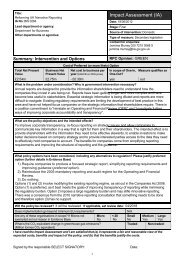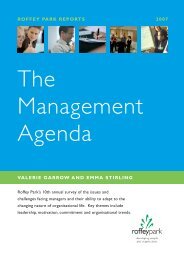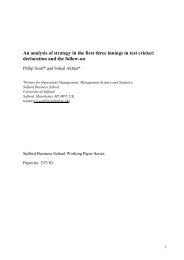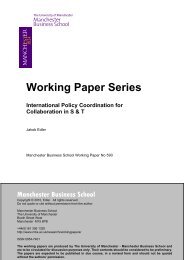Research Paper - Management and Business Studies Portal
Research Paper - Management and Business Studies Portal
Research Paper - Management and Business Studies Portal
Create successful ePaper yourself
Turn your PDF publications into a flip-book with our unique Google optimized e-Paper software.
Although most cases were in traditional unionised sectors, a few of the mostsuccessful were with companies in industries or occupations not typically associatedwith unionization.In the most successful cases, union officials seemed to adopt co-operative, pragmaticapproaches to company management, working jointly with management to solveidentified employee problems. Examples of this attitude include:• In a company with a factory line, the union negotiated to limit the company’spiece-rate pay scale in return for union attention to unnecessary productwaste.• In a company with high worker turnover, the union negotiated a substantialpay rise <strong>and</strong> worked with the company to improve morale among low-wageoccupations.• In a company intensely hostile to unions, after recognition the unionimmediately started negotiating with the company on how to introduce new 24-hour, 7-day schedules into the company; after negotiating with the company toset up a more equitable pay schedule, the union worked with the company tobegin fair employee evaluations.Among the eleven cases where unions had only minimal or weak bargainingrelationships, the union official tended to view the company as sticking very close tothe legal minimum, negotiating over nothing more than that required technically bythe new statute. In at least one case, company management never met with unionofficials for official negotiations, instead sending lawyers or other representatives.Some examples of the problems encountered in these cases included:• In a company with a traditionally strongly organized industry, the union officialwas very disappointed with the strictly legalistic approach taken by management;from the official’s point of view, the union would likely never have a constructiverelationship with the company when faced with such a narrow bargaining position.• In a company without any union history, the company negotiated through itslawyer; the union official had found it difficult to get continuing support theworkforce <strong>and</strong> was having difficulty in recruiting local union representatives.• In a number of companies the managing director continued personally to take ahard-line attitude against union inclusion.Among the three cases where the union has found itself in a bad bargainingrelationship, two involved companies with managing directors who remain personallyvehemently opposed to union activity, <strong>and</strong> the third involved a company with a longhistory of working against union influence. In one case, the manager overrode thenearly-completed union negotiations to personally impose a pay settlement; in theother case, the manager simply ignored all communications on the CAC process. Inthe third case, the company set up parallel working groups on pay, hours, <strong>and</strong>holidays without including any union representation.5. U.K. Innovations Add Incentives for Productive NegotiationWhile some of the difference in outcomes between the U.K. <strong>and</strong> the U.S. statutoryrecognition schemes can be attributed to divergent cultural traditions, the UnitedKingdom has also revised the basic North American recognition model to includespecific impetus to productive labor negotiations. xvi11
















